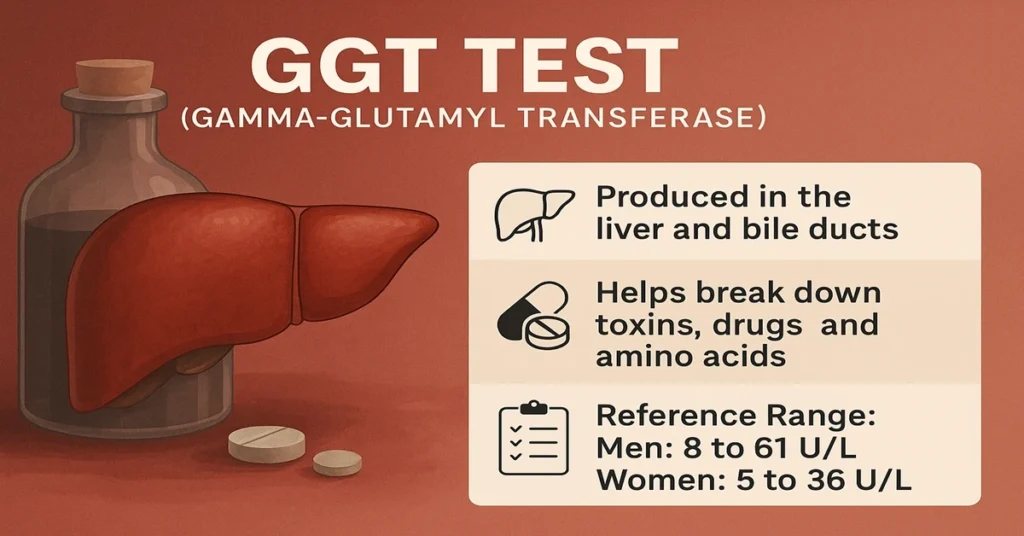Introduction
The GGT test (Gamma-Glutamyl Transferase test) is an important blood test used to evaluate liver health and bile duct function. GGT is an enzyme present in many parts of the body, but it is especially concentrated in the liver and bile ducts.
Doctors often use this test to detect liver damage, blockage of bile flow, and the effects of alcohol or certain medications. It is highly sensitive and can often detect problems even before symptoms become obvious.
What is GGT?
Gamma-Glutamyl Transferase (GGT) is an enzyme that helps the body in breaking down amino acids and plays a crucial role in detoxification.
The GGT Test measures the level of this enzyme in blood. High levels generally indicate liver or bile duct damage, while low levels usually suggest normal or healthy function.
Where is GGT Produced in the Body?
GGT is produced in several organs, though the liver and bile ducts are the most important sources.
- Main sources:
- Liver
- Bile ducts
- Other sources:
- Kidneys
- Pancreas
- Intestines
- Spleen
Functions and Importance of GGT
GGT has several biological functions:
- Breaks down and transports amino acids across cell membranes.
- Involved in glutathione metabolism, a key antioxidant system that detoxifies harmful substances.
- Helps remove toxins and drugs from the body.
From a clinical perspective, the GGT test is used to:
- Detect liver damage.
- Identify blockage in bile ducts (caused by gallstones, tumors, or scarring).
- Monitor alcohol abuse and its effect on the liver.
- Evaluate the impact of liver-toxic medications.
Causes of Low GGT
Low GGT is generally not a medical concern. It usually indicates:
- Healthy liver function.
- Low or no alcohol consumption.
- Rarely, it may be seen in hypothyroidism (underactive thyroid).
Symptoms of Low GGT
- Low GGT itself does not cause symptoms.
- It is usually seen as a normal or healthy finding.
Causes of High GGT
High GGT levels are much more clinically significant. They can occur due to many liver-related or bile-related conditions, such as:
- Alcoholic liver disease.
- Fatty liver disease (including non-alcoholic fatty liver).
- Hepatitis or cirrhosis.
- Blockage of bile ducts (gallstones, strictures, or tumors).
- Liver damage from drugs or toxins.
- Liver cancer or cancer that has spread to the liver.
- Heart failure, which may affect the liver.
- Pancreatitis (inflammation of the pancreas).
Medications and substances that raise GGT:
- Anti-seizure drugs (e.g., phenytoin).
- NSAIDs (painkillers).
- Antibiotics.
- Statins (cholesterol medicines).
- Alcohol (chronic use significantly raises GGT).
Symptoms of High GGT
The symptoms of high GGT are usually due to the underlying liver or bile duct problem. Common signs include:
- Fatigue or weakness.
- Jaundice (yellowing of the skin or eyes).
- Abdominal pain, especially in the upper right side.
- Dark urine.
- Loss of appetite.
- Nausea or vomiting.
- Swelling in the legs or abdomen (ascites, seen in cirrhosis).
Reference Range (Normal Values)
- Men: 8 to 61 U/L
- Women: 5 to 36 U/L
(Ranges may vary slightly depending on the laboratory.)
Note: GGT values are usually higher in men and in people who consume alcohol regularly.
Sample Type and Collection
- Sample Type: Serum
- Tube Used: Red Top (Plain Tube)
This is a simple blood test. Usually, no special preparation is needed, but your doctor may ask you to avoid alcohol and certain medications before the test for accurate results.
Test Preparation
- Avoid alcohol for at least 24–48 hours before the test.
- Inform your doctor about medications, as some drugs affect GGT levels.
- Fasting may sometimes be required if other liver tests are done together.
When to Consult a Doctor
See a doctor if you notice:
- Persistent fatigue or weakness.
- Yellow skin or eyes (jaundice).
- Pain in the upper right side of the abdomen.
- Dark urine or pale stools.
- Swelling of the legs or abdomen.
- History of heavy alcohol use or liver-toxic drugs.
Early testing can help prevent serious liver damage.
Important Word Explanations
- GGT (Gamma-Glutamyl Transferase) – An enzyme mainly found in the liver and bile ducts.
- Bile ducts – Small tubes that carry bile from the liver and gallbladder to the intestine.
- Cirrhosis – Long-term scarring of the liver due to chronic damage.
- Ascites – Accumulation of fluid in the abdomen, often seen in advanced liver disease.
- Glutathione – A powerful antioxidant involved in detoxifying harmful substances.
~END~

